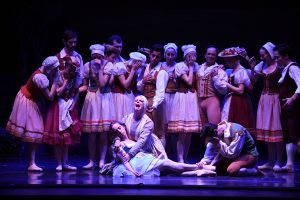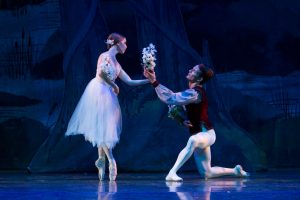City Ballet’s “Giselle” is a Gem

Photo: Anna Scipione
Like an exquisitely cut diamond, City Ballet of San Diego’s “Giselle” didn’t just sparkle at the Spreckels Theatre on Saturday. Moment to moment, the production displayed exciting new facets of this Romantic classic, via stunning lead performances, the better-than-ever company orchestra, and a corps of villagers that radiated joy.
Ariana Gonzalez played Giselle, the sweet village girl who falls for Albrecht, then learns he’s a nobleman who’s been toying with her, and dies of grief. Giselle is supposed to have a weak heart, and some legendary Giselles (like Alessandra Ferri) can make you believe it, looking tremulous while dancing with the power of Olympic athletes. That isn’t the case with Gonzalez, who, even at her most girlish, exudes strength. No matter, her dancing dazzled. She was rock-solid hopping on one toe, precise in the C-shaped jump in Act II, throwing her head and feet to one side. And she passionately conveyed Giselle’s anguish when Albrecht was unmasked.

Photo: Chelsea Penyak
Gonzalez had a superb dramatic partner in Iago Breschi as Albrecht. Breschi, a Brazilian in his first season with City Ballet, is not only a powerhouse dancer, but Gonzalez’s match for expressiveness. As Albrecht’s deception was revealed, Breschi squirmed with a delicious caddishness I hadn’t seen in this role. And when he got on his knees and begged Giselle’s mother (Kimberly Roberts) for forgiveness, wow! She rebuked him with such sharp gestures, I thought she was going to rip him limb from limb—and I hated Albrecht so much, I wanted her to do it. (Roberts was a City Ballet principal for years, and the star power showed.)
Megan Jacobs was an elegant, icy Myrtha, Queen of the Wilis—the spirits of girls who died before their weddings, a sorority Giselle joins in Act II. And Geoff Gonzalez seethed as Hilarion, who truly loves Giselle.
The only disappointment among Saturday’s leads were Sumire Ito and Ryosuke Ogura in Act I’s Peasant pas de deux. The pair lacked chemistry; Ogura kept glancing at Ito and then into the audience, as if to make sure we were still there.
The rest of the peasants, however, were enchanting. Giselle’s six friends showed sprightly footwork, and six peasant couples made 19th century village life look like a joyous nonstop party. The corps women were also strong in Act II as Wilis doing their signature arabesque penchée. This company has always had a strong corps de ballet, but choreographer Elizabeth Wistrich took them to a new level here. (Wistrich worked with the classic choreography of Jules Perrot, Jean Coralli, and Marius Petipa.)
“Giselle” represents a new level for the City Ballet Orchestra, as well. Director John Nettles has, over a number of years, developed a competent ensemble. On Saturday, the 37-member orchestra went beyond competence playing the Adolph Adam score. In particular, they brought rich color to Giselle’s theme, heard initially when she’s innocent and happy; the same theme threads in later with increasingly dark undertones.
The production was also a visual delight, with costumes and sets borrowed from the Sacramento Ballet.
“Giselle” played last weekend only. But you have a chance to catch this company again May 11-13, when they’ll perform “Carmina Burana.

Award-winning dance journalist Janice Steinberg has published more than 400 articles in the San Diego Union-Tribune, Dance Magazine, the Los Angeles Times, and elsewhere. She was a 2004 New York Times-National Endowment for the Arts fellow at the Institute for Dance Criticism and has taught dance criticism at San Diego State University. She is also a novelist, author of The Tin Horse (Random House, 2013). For why she’s passionate about dance, see this article on her web site, The Tin Horse

Thank you for the well-written article. As principal trumpet for the ballet, it was gratifying to see the orchestra mentioned. We have a solid core of dedicated professional musicians who put months of work in on our performances behind the scenes, buying music, rewriting parts, and of course practicing, all before the first rehearsal.